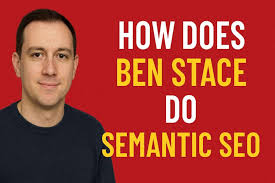How Does Ben Stace Do Semantic SEO?
Introduction
If you’ve ever wondered how does Ben Stace do semantic SEO, you’re tapping into a strategy rooted in meaning, context, and authority—not just keywords. In an era where search engines like Google reward content that demonstrates depth, intent, and topical expertise, Ben Stace stands out as a practitioner who elevates SEO beyond traditional tactics. His approach emphasizes topic mapping, structured content, entity optimization, and continuous refinement. This article explores how Ben builds semantic authority, crafts content with intent, and structures websites to align with how modern search engines understand language and user queries.

Mapping Topics, Entities, and Searcher Intent
At the heart of Ben’s strategy lies sophisticated topic and entity research. He doesn’t start with a list of keywords; instead, he maps topics and their associated entities—people, brands, tools, concepts—using tools like Google’s Knowledge Graph, InLinks, and Wikipedia White Hat SEO GuruBoostRankify. This process allows him to build topical maps and clusters—a network of content where a comprehensive pillar page is surrounded by in-depth, interlinked subtopics White Hat SEO GuruBoostRankify. Not only does this convey expertise, but it also signals to search engines that the site is a credible authority on the subject.
Ben also performs gap analysis by auditing existing content against top-ranking competitor pages. If a key concept or entity—say “grind retention” in a coffee content piece—is missing, he fills that gap to ensure his content speaks the complete topic language LinkedIn.
Writing for Meaning, Not Just Search Terms
Ben’s content creation is guided by user intent and semantics, not mere keyword frequency. He tailors each piece based on whether users are searching for information, making comparisons, or executing a purchase—using formats like FAQs, how-to guides, or comparison tables as needed White Hat SEO GuruRank Invention. He uses semantic keywords and natural language—phrases related to the topic that reflect real human search patterns. For example, writing about cameras might include terms such as “sensor size,” “low light performance,” or “mirrorless vs DSLR,” rather than repeating “best camera” over and over White Hat SEO GuruAshir Digitals.
Ben also structures content to target Featured Snippets and “People Also Ask” boxes. He frames questions with headings and provides concise answers (typically 40–60 words) immediately beneath, increasing visibility in search results White Hat SEO GuruLinkedIn.
Structured Data and Schema for Semantic Clarity
Understanding that Google looks for more than just words, Ben implements schema markup—including FAQ, HowTo, Article, and Author types, among others—to help search engines interpret his content accurately White Hat SEO GuruBoostRankify. He adds entity-focused markup like Person, Organization, or detailed JSON-LD structures to align the page with search engine knowledge graphs BoostRankifyLinkedIn.
Internal Linking: From Pillars to Depth
Ben crafts smart internal linking by using descriptive, context-rich anchor text that connects thematic clusters—guiding users and search engines through related content White Hat SEO GuruLinkedIn. This approach ensures pages don’t become “orphaned” and strengthens the semantic signal of content hubs or silos BoostRankifyLinkedIn.
Emphasizing EEAT and Credibility Signals
Ben embeds EEAT principles (Experience, Expertise, Authoritativeness, Trustworthiness) across his content. He references real case studies, uses author biographies with credentials, links to reputable external sources, and ensures regular updates for freshness and trust BoostRankify. These human-centered credibility signals help lift content in a landscape that values authenticity.
Modular Content and Ongoing Refinement
Ben structures content in modular blocks—sections that can be independently updated when new topics emerge or algorithms shift LinkedIn. He schedules ongoing audits to identify emerging entities, user questions, or structural gaps, ensuring the content ecosystem remains adaptive and relevant LinkedInOptimizo.
Tools That Power Semantic Strategy
To execute his approach efficiently, Ben relies on a tech stack that includes:
- InLinks & Google NLP API for entity detection and mapping,
- MarketMuse, Surfer SEO, Frase.io for NLP-driven content scoring and optimization,
- Tools like Screaming Frog or Sitebulb for technical audits,
- Custom tools like his “Semantic SEO Writing Tool” and “Semantic Scan” to guide writers toward semantic depth and completeness Guest Post AgencyWider WeeklyBoostRankify.
Proven Results and Client Success
Case studies validate his method:
- A SaaS site struggling with poor results saw improvement by transitioning content into semantic clusters and pillar pages Neybg.
- A dental clinic increased organic leads by 58% through a semantic content hub on oral health topics Neybg.
- Testimonials describe triple-digit growth in organic traffic and improved topical authority, emphasizing his impact on impressions and user engagement BoostRankify.
Why Ben Stace’s Semantic SEO Works
Ben’s framework aligns with how modern search engines process language—through understanding semantics, entities, and natural intent. By building content ecosystems that reflect deep topical research, clear structure, credibility, and adaptability, he ensures that sites stand out as contextually relevant and authoritative. It’s SEO that anticipates Google’s evolution—turning content into meaning, not just keywords.
Conclusion
Exploring how does Ben Stace do semantic SEO reveals a sophisticated methodology centered on meaning, structure, and user-first logic. Through topic mapping, entity optimization, strategic internal linking, schema implementation, EEAT emphasis, and continuous content refinement, Ben helps websites thrive in today’s semantic search world. His approach isn’t just about ranking—it’s about being the most relevant, trusted resource in the digital ecosystem. By adopting his principles, content creators and SEOs can increase SEO insights and build a strong foundation for long-term organic success.